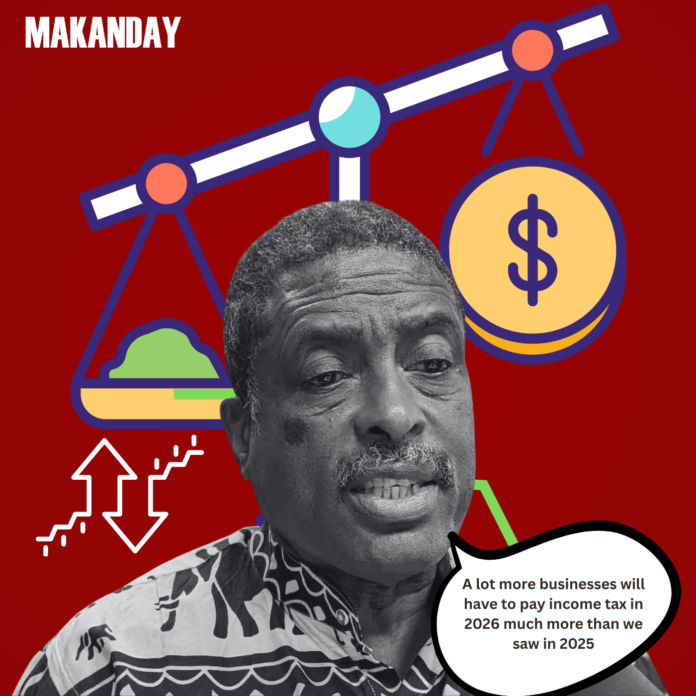By Linda Soko Tembo
An economist has described this year’s K223 billion national budget as a “feel-good” and politically motivated budget, saying it prioritises popularity over prudence and raises serious concerns about economic realism, sustainability, and the government’s ability to deliver on its promises without triggering instability.
In an interview with MakanDay, Yusuf Dodia observed that the government is projecting a 25% increase in income tax, along with significant rises in Paye As You Earn (PAYE) and Value Added Tax (VAT) collections, targets he described as unrealistic, given Zambia’s slow job creation and limited private-sector growth.
Pre-election populism
Dodia noted that, despite increased allocations to social protection, job creation, and infrastructure, the mining sector, Zambia’s main revenue source, remains largely under-addressed, with only a marginal increase in mineral royalty revenues.
He explained that the overall structure and tone of the 2026 budget reflect President Hakainde Hichilema’s address to Parliament on 12 September 2025, which emphasised improving citizens’ livelihoods.
According to Dodia, the budget’s spending plan appears strategically aligned to boost public support ahead of the general elections. However, he cautioned that while the spending intentions may be popular, the means of financing them remain unclear.
Dodia explained that the revenue targets for 2026 appear highly ambitious, with income tax collections projected to rise from K65 billion in 2025 to K82 billion in 2026, an increase of 25%. Similarly, PAYE is expected to grow from K26 billion to K31 billion, while VAT collections are forecast to rise from K48 billion to K54 billion over the same period.
“If that’s the case, it means a lot more businesses will have to pay income tax in 2026 much more than we saw in 2025,” he said. “That would suggest a healthier and more productive economy, but I am not sure how achievable that is, it might be a bit ambitious.”
“For example, PAYE brought in K26 billion in 2025, and the target for 2026 is K31 billion an increase of K4 billion or about 6 percent. To raise that K4 billion, it would require creating roughly 1.6 million new low-income jobs, which is a difficult number to turn into reality,” he added.
Dodia said another area of concern is the shift in financing sources. While the government plans to reduce foreign financing from K19 billion to K12 billion, a 34% drop, domestic borrowing is expected to rise sharply from K15 billion to K21 billion, representing a 41% increase.
“This raises the risk of crowding out the private sector this is going to be a tough year I think in terms of general economic stability and growth,” he said.
Dodia explained that despite its ambitious spending, the 2026 budget fails to address key structural issues necessary for long-term economic growth. He noted with concern that there was no mention of the Export Proceeds Tracking Framework (EPTF), a system that has been instrumental in stabilising foreign currency inflows.
The EPTF, an initiative of the Bank of Zambia, requires all exporters to channel their earnings through Zambian bank accounts within 90 days of shipment. The framework enhances transparency, strengthens the bank’s oversight of foreign exchange flows, and improves financial management by allowing for the tracking and reconciliation of export proceeds against declarations made to the Zambia Revenue Authority (ZRA).
“There was silence from both the President and the Minister of Finance on the EPTF, and that’s worrying,” Dodia said. “If this mechanism is revoked or weakened, the country could face serious foreign exchange shortages.”
He added that signs of pressure on the foreign exchange market are already visible. The BoZ’s recent proposal to enforce the use of the Kwacha in local transactions has been interpreted by some as a reflection of growing concern over dollarisation and limited forex availability.
“If foreign exchange was abundant, there would be no need to enforce such rules,” he said. “The fact that this is happening suggests we’re bracing for a shortage. If the EPTF isn’t maintained, the kwacha could easily slide to between K28 and K30 per US dollar.”
Dodia concluded that while the 2026 budget promises broad-based benefits for citizens, the ability to deliver them without triggering fiscal or macroeconomic instability remains a serious challenge.
He described it as a typical pre-election budget, noting that allocations to certain sectors such as the Constituency Development Fund have increased despite persistent concerns over misuse and mismanagement. Social protection programmes such as the Social Cash Transfer and the Farmer Input Support Programme under the e-voucher system have also received notable increases.
“The government has expanded initiatives like the Cash for Work programme and school feeding schemes, alongside a boost in public-sector employment, with more teachers and health workers recruited this year and plans for additional hiring next year,” he said. “Substantial funding has also been directed toward the construction of new health centres and the expansion of schools.”
However, Dodia emphasised that the mining sector, the so-called ‘elephant in the room,’ remains largely untouched. Despite its importance to the economy, the only movement is a marginal rise in mineral royalty revenues from K17 billion in 2025 to K18 billion in 2026, raising questions about whether the sector is being adequately leveraged for national development.

Discover more from MAKANDAY
Subscribe to get the latest posts sent to your email.



